Jaeger-LeCoultre Duomètre à Sphérotourbillon FULLY EXPLAINED
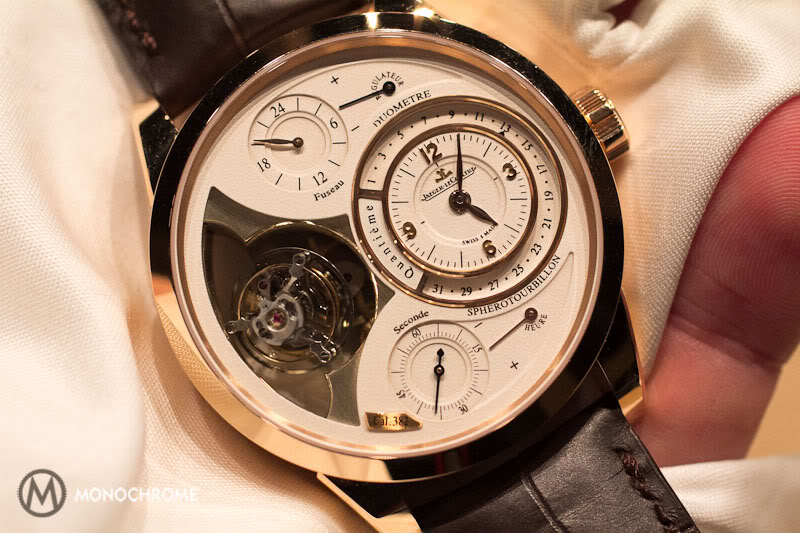
Since a few years, Jaeger-LeCoultre offers, with the Duomètre collection, the perfect logical next step in the evolution of mechanical watches with a complication. The idea is as simple as it is ingenious and it accomplishes a much more precise rate for Duomètre watches with the so-called Dual-Wing construction.
After the Duomètre à Quantième Lunaire 40.5, Jaeger-LeCoultre adds a magnificently beautiful tourbillon that also features this Dual-Wing construction, to the collection. This is the Duomètre à Sphérotourbillon. Let us explain exactly how this Dual-Wing concept works…

When a watch features complications, whether they are a date, a moon phase or a chronograph, the going rate of the watch is influences negatively. Jaeger-LeCoultre has the Dual-Wing construction to avoid these negative influences.
Jaeger-LeCoultre’s Dual-Wing concept
In essence a watch is made to indicate the time and its mechanical movement has to be regulated to indicate time as precise as possible. Most mechanical watches are regulated in 5 positions and this is done when the hour, minute and seconds hand are moving.
Every influence on the simple time-keeping of a watch, is something that comes with additional forces in the movement; forces that cause a negative influence on the precise time-keeping of a watch. For instance a date; this is a complication that changes once every 24 hours. The changing of the date is activated by gears or levers and the date wheel or date hand makes a jump. To make the date wheel or pointer date hand jump, some force is needed. In a small mechanical movement, these forces are relatively large. So large that they will effectively cause the watch to run less precise, during the complication’s activation.
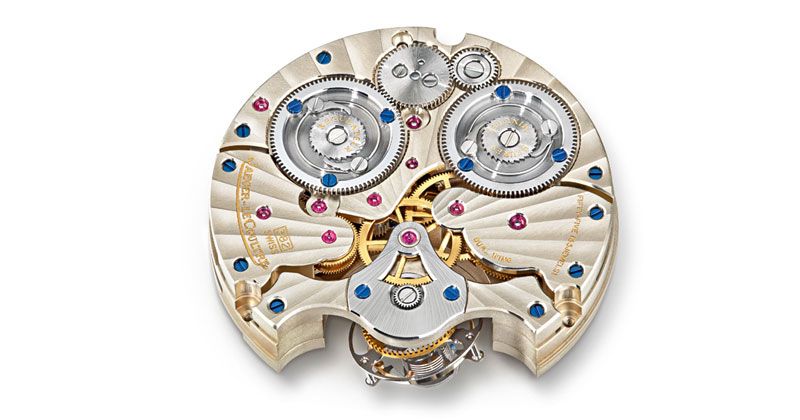
What Jaeger-LeCoultre did was to create two separate gear trains and main spring barrels, each driving a part of the watch. One to drive the time and one to drive the complication. This way the “time indicating part” of the watch runs free of negative influences.
If there is no connection between these two parts, time indication and complication, they each run at their own pace entirely independent from each other. And that’s not what’s supposed to happen of course. It would be strange if the date changed at different moments than at 12 o’clock midnight. So that’s why both gear trains are connected by a shared regulating organ. This is the Dual-Wing concept that Jaeger-LeCoultre implemented in their Duomètre collection.
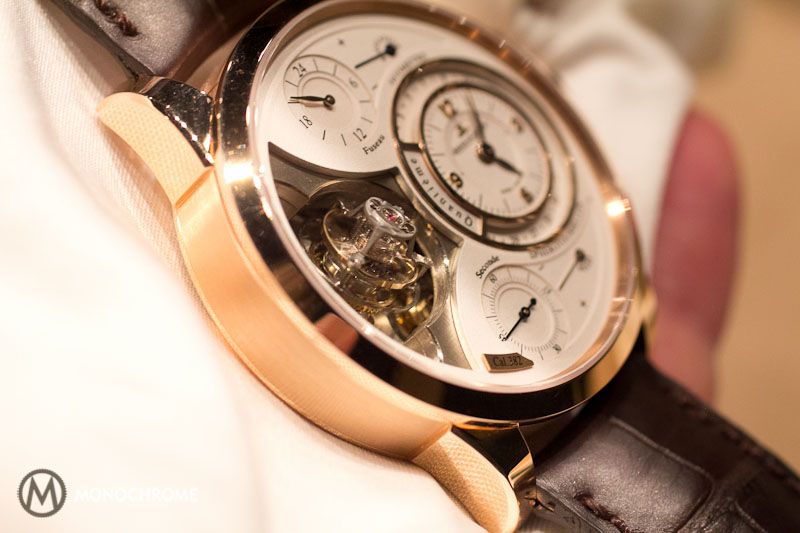
The Spherotourbillon
The Duomètre à Sphérotourbillon also adds a tourbillon, but not a normal tourbillon. As well as revolving around the axis of its carriage, the tourbillon also spins around a second axis, inclined at a 20° angle. The combination of these two distinct and fast rotations (respectively 30 and 15 seconds per revolution) provides a much better ‘protection’ from negative gravitational forces than any standard tourbillon, which is designed for pocket watches. A pocket watch is carried upright, in a pocket, while a wrist watches is moved in many positions while it’s on the wrist. Therefore the standard tourbillon is a nice feature, however not tailored for a wrist watch.
Our contributor Time2tic made this video of the Spherotourbillon
No ordinary balance spring: Furthermore this tourbillon features a cylindrical balance-spring, like the Montblanc Tourbillon Bi-Cylindrique,with two terminal curves. This beats with a concentricity impossible to achieve with a traditional balance-spring. The balance oscillates at a cadence of 21,600 vibrations per hour. The balance-spring stud-holder is protected by a screw-locking system from the effects of shocks and vibrations to which the watch is subjected.

Precision time-setting: Another feature of the Sphérotourbillon, is that it can be adjusted to the second, something that isn’t possible with a normal tourbillon. In order to enable the wearer to set time to the second, it doesn’t feature a usual stop-seconds or hacking mechanism. A stop-seconds or hacking mechanism would stop the regulating organ, in this case the tourbillon. Stopping the regulating organ isn’t the real problem, but after setting the time, the regulating organ should get up to speed again; something that negatively influences precise time-keeping.
Jaeger-LeCoultre found a much more logical solution for setting the time exact to the second, by means of a flyback mechanism for the seconds hand. A push-piece at 2 o’clock serves to bring the small seconds hand positioned beneath the tourbillon back to zero. The small seconds hand is reset to zero and begins running again instantly. This means the watch maintains optimal precision even when accurately adjusting the time to the second.
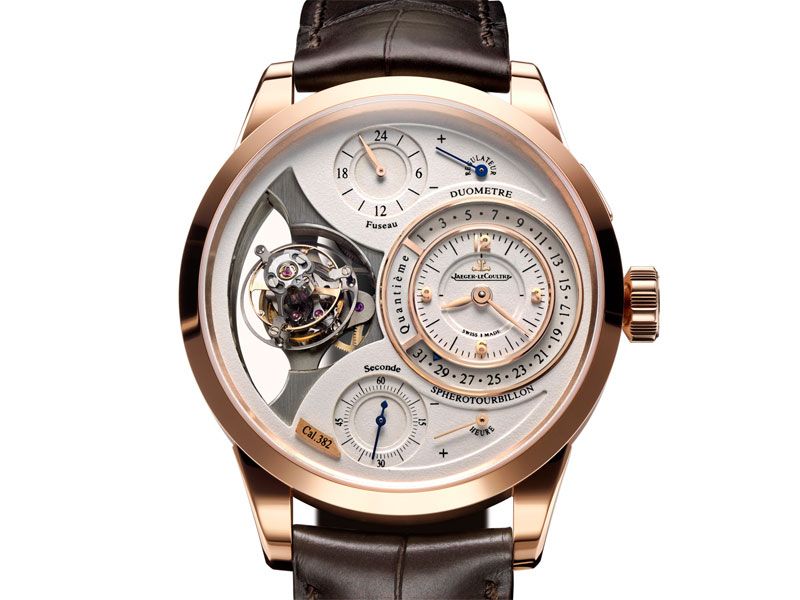
Let’s have a look at the design and functions of the Duomètre à Spherotourbillon, after explaining all the technical features. The hours and minutes are indicated in a off-center positioned dial on the right side of the face. Surrounding that dial, the date is indicated by a date hand, that rotates below the hours/minutes dial.
Above and below the hours/minutes dial, are two power reserve indicators, for the two main spring barrels. One for the main spring powering the hours/minutes indicated ‘Heure’ and the other for the main spring barrel that provides the complication with power, indicated ‘Regulateur’. The small seconds hand is positioned to the lower side of the face and toward the top is a 24-hour second time zone hand.
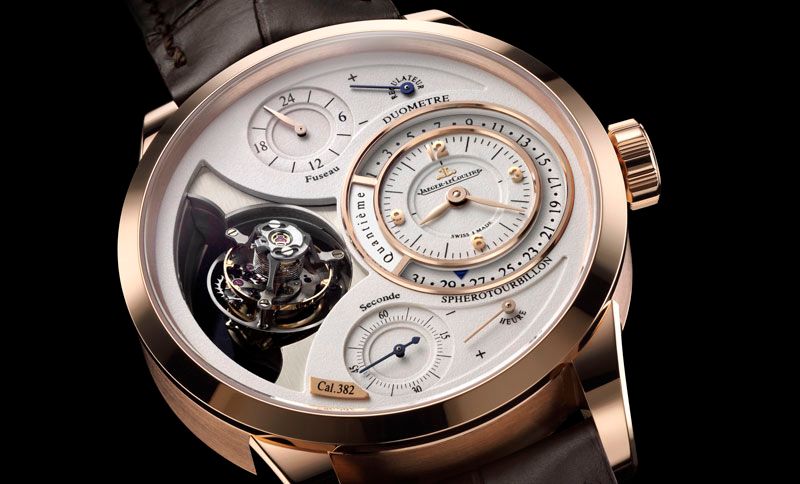
The dial shows the same gorgeous fine grain finish and multi layered design, that can also be found on the Duomètre à Quantième Lunaire 40.5, its larger predecessor and award-winning Duomètre à Quantième Lunaire and the beautiful Master Geographic that we reviewed last year.
The movement, caliber 382, is crafted, assembled and decorated by hand, and features gorgeous nickel silver (also called German silver) bridges and main plate. The finish is extraordinary, featuring Jaeger-LeCoultre’s signature ‘côtes soleillées’. Its case measures 42 mm in diameter and is, despite the Sphérotourbillon, just 14.1 mm thick. The bezel and bezel and lugs are polished and the case middle features a lovely satin-brushed finish.
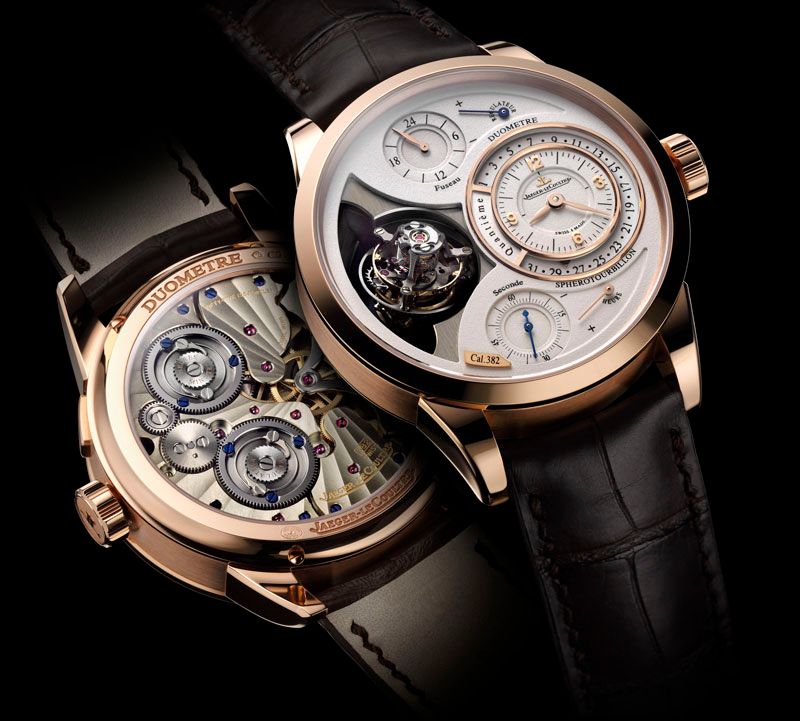
Jaeger-LeCoultre Calibre 382
- Hand-winding
- Pieces number : 460
- Vibrations per hour : 21600
- Power-reserve : 50 Hours
- Jewels : 55
- Barrels : 2
- Height : 10.45 mm, Diameter: 33.70 mm
Case
- Pink Gold 18 carats
- Diameter: 42 mm, Thickness: 14.1 mm (including the sapphire crystal)
- Polished and satin-brushed finish
- Domed glareproofed front and back sapphire crystals, hardness n°9
- Water resistance : 5 bars
For more information you can visit the Jaeger-LeCoultre website.
This article is written by Frank Geelen, executive editor of Monochrome Watches.



